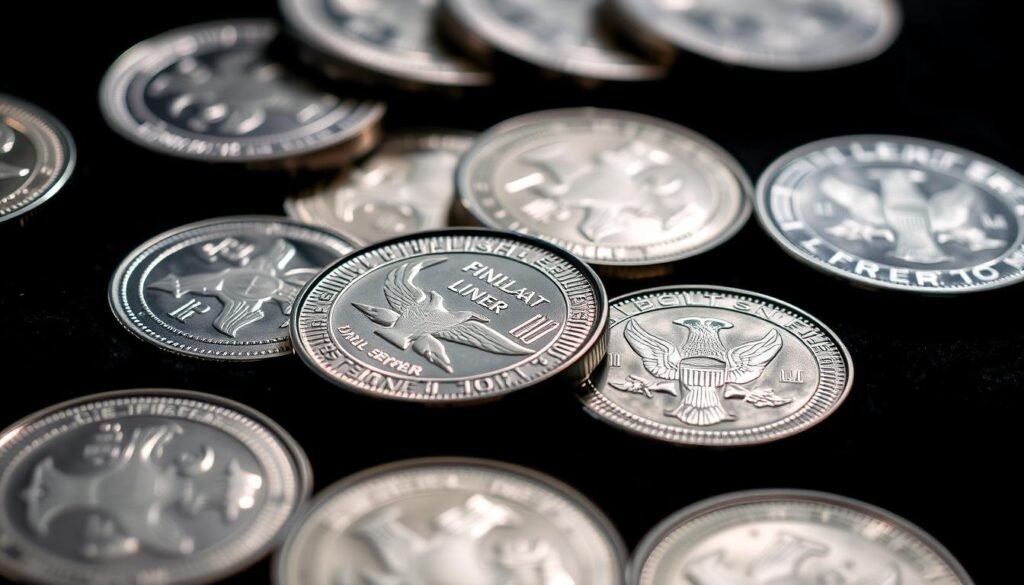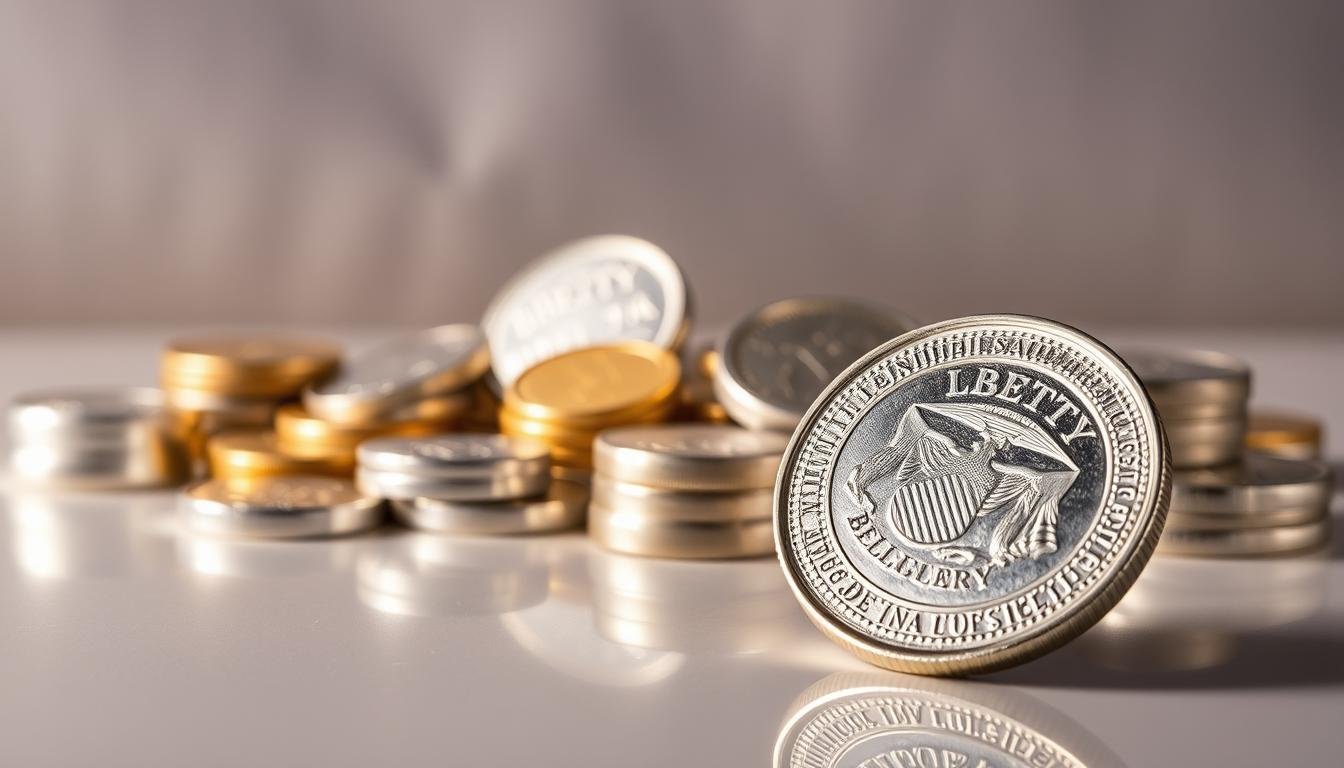I started adding physical metals to my retirement because headlines kept me awake at night. I wanted real assets that sit outside corporate balance sheets and help cushion my portfolio during spikes in inflation and volatile markets.
My approach is practical: I use a silver ira within a broader mix of equities and bonds to balance growth and downside protection.
Owning tangible precious metals helps me sleep better—not by timing the market, but by holding assets with long-term purchasing power and unique industrial demand that can support price over cycles.
I follow IRS rules: a qualified custodian, approved depository, and bullion that meets purity standards. To learn more about eligible holdings and custody, see this guide on how such accounts work for IRAs holding precious metals.
Key Takeaways
- Adding physical metals can diversify your retirement portfolio and hedge inflation.
- A compliant account requires a qualified custodian and approved storage.
- I balance metals with stocks and bonds—it’s an addition, not a replacement.
- Industrial demand and market forces can support price over the long term.
- Be mindful of fees, liquidity, and the logistics of buying and storing bullion.
What a Self-Directed Silver IRA Is and How It Works
Moving part of my savings into physical metal taught me the operational steps you won’t see in a brokerage statement.
I define a silver ira as an account that lets me hold 99.9% pure bullion and IRS-approved coins inside a tax-advantaged ira rather than only owning stocks and bonds in a brokerage-format account.
The big difference is choice and process. Traditional accounts offer instant trading of stocks bonds and funds. A metals setup requires me to coordinate with a custodian, a dealer, and an approved depository for storage.
IRS oversight, eligible assets, and logistics
The IRS limits eligible precious metals to specific purity levels and coins—American Silver Eagles qualify, but collectible coins do not. I never store holdings at home because the IRS requires approved depositories.
Operationally, I submit buy directions to my custodian. The dealer ships the metal to a depository, which credits the holdings to my account records. This flow protects compliance and avoids tax-triggered distributions.
“I value clear roles: the custodian handles paperwork, the dealer sources metal, and the depository secures storage.”
- Custodians like Equity Trust, Strata Trust, and New Direction Trust simplify reporting.
- Depositories such as Delaware Depository meet IRS storage rules.
- Metals are less liquid than mutual funds, so planning matters.
Why Silver Belongs in My Retirement Portfolio Right Now
I add tangible metals to my savings because they change how I think about risk.
Diversification beyond stocks, bonds, and mutual funds
I put a portion of my portfolio into a silver ira to reduce correlation with stocks and bonds. That way one slump won’t define my retirement outcome.
Hedge against inflation and a weakening dollar
I use metal as a partial hedge when inflation climbs and the dollar falls. Historically, precious metals have helped preserve purchasing power during uncertain periods.
Industrial demand tailwinds from solar, electronics, and emerging tech
Real-world uses—solar panels, electronics, and new tech—support long-term demand. That industrial pull helps explain why the price topped $36 per ounce in June 2025.
Accessibility versus gold: price per ounce and growth potential
Silver is more volatile than gold, but it costs far less per ounce. For investors who want to build positions in smaller increments, that accessibility is a clear benefit.
“I balance silver with gold and my core index exposure so my precious metals sleeve is a complement, not a replacement.”
- I accept higher volatility and manage size and time horizon.
- I choose IRS-approved coins and bars to keep the account compliant.
- I weigh diversification and inflation hedging against liquidity and storage trade-offs.
self directed ira silver: Rules, Eligibility, and IRS Compliance
To protect tax benefits, I stick to precise rules for eligible metals and storage.
Purity matters. The IRS requires 99.9% purity for IRA-eligible silver bullion and coins. I verify fineness on each product and confirm the mint or manufacturer is approved.
I avoid collectible and numismatic coins because regulations disallow them even when purity looks acceptable. I also insist on clear invoices and product specs so my custodian can document the purchase.
Custodian and depository roles
A qualified custodian must hold title and handle reporting. I work with custodians like Equity Trust or Strata Trust to keep records clean.
All metals must go to an approved depository. I never store holdings at home or in a bank safe-deposit box. Delaware Depository is a common choice for secure storage.
- I confirm bars and bullion meet fineness standards before funding orders.
- I send invoices, mint certificates, and custodian authorization with every purchase.
- I pick storage (segregated or pooled) to match my need for specificity and cost control.
“Documentation, an approved depository, and a qualified custodian are non-negotiable for compliance.”
Step-by-Step: How I Open, Fund, and Buy Silver in a Precious Metals IRA

Clarity matters: I follow a repeatable process to open, fund, and buy bullion inside my tax account so nothing trips compliance.
Choosing the right account type
I pick among Traditional, Roth, or SEP based on current versus expected tax brackets. In 2025 the contribution limit is $7,000 under 50 and $8,000 if I’m 50 or older. I also check Roth income limits ($161,000 single; $240,000 joint) before deciding.
Selecting a custodian and storage
I shortlist custodians experienced with precious metals ira work, like Equity Trust or Strata, and compare fees and portals. Then I choose an IRS-approved depository, for example Delaware Depository, and pick segregated or pooled storage based on cost and tracking needs.
Funding and placing orders
I fund the account via contributions, an IRA-to-IRA transfer, or a rollover from a 401(k). I confirm funds are posted before I lock pricing with a dealer.
- I buy eligible silver coins and bars only from reputable dealers and confirm purity and mint.
- The dealer ships bullion directly to the approved depository; shipments to my home are not allowed.
- I attach dealer invoices to my Direction of Investment so the custodian records the holdings.
“Account funded, DOI approved, depository confirmed, shipment tracked, and holdings reconciled.”
Smart Rollovers and Transfers from Existing Retirement Accounts
When I move retirement assets, I treat transfers as a carefully timed project. That mindset keeps my tax exposure low and the paperwork tidy.
IRA-to-IRA transfers are my default. I request custodian-to-custodian moves so funds never touch my hands. That avoids withholding and keeps the transfer tax-free.
Rolling over a 401(k) or 403(b)
I always contact the plan administrator first. They tell me eligible rollover options, required forms, and timing. A direct rollover to my new ira or a metals ira preserves tax status and avoids mandatory withholding.
Avoiding common pitfalls
I avoid indirect rollovers when possible because the one-rollover-per-12-months rule and potential 20% withholding create risk for investors. I also confirm beneficiary and titling details during every move.
- I open the destination account, initiate the transfer, then confirm receipt of funds before buying metal.
- I avoid liquidating my stocks bonds prematurely; I time sales to limit market exposure.
- I keep copies of distributions, receipts, and trade confirmations for tax and compliance records.
“Direct custodian transfers and a tax pro’s review make the process smooth and protective of benefits.”
Finally, I check fees and processing times with both custodians and consult a tax professional to verify regulations and avoid surprises.
What I Actually Buy: IRA-Eligible Silver Coins, Bars, and Storage Choices

I choose pieces that meet IRS purity rules and sell easily when I need liquidity. I favor recognized coins like American Silver Eagles and bars from accredited mints because they clear custodian checks fast.
My mix balances premiums and resale value. Bars often carry lower premiums per ounce, while certain coins make transactions smoother with dealers and secondary buyers. I confirm each bullion item shows 99.9% fineness and the mint name so the custodian can approve the purchase without delays.
Storage and insurance choices
I always use an approved depository such as Delaware Depository. Custodians and dealers coordinate shipping so the depository verifies and records receipt.
For storage I weigh segregated versus non-segregated options. Segregation costs more, but it guarantees the exact items are mine. Pooled storage saves money but does not identify individual bars or coins.
- I check depository insurance and reporting cadence before finalizing storage.
- I sometimes add a small allocation to gold coins or bars for diversification within my metals sleeve.
- I verify dealer buyback terms and keep an alternate product choice in each order to avoid stock delays.
“I prioritize recognized mints, clear fineness, and secure, IRS-approved storage so my account stays compliant and liquid.”
For further reading on downsides to precious metals allocations, see this detailed piece on the negatives of a gold IRA.
The Real Costs, Risks, and Ongoing Management of a Silver IRA
I track every fee and timing detail so costs don’t quietly erode my retirement plan.
Setup and recurring fees matter. I budget for account setup, annual administration, purchase and sale fees, and depository storage so surprises don’t eat returns.
I verify depositories’ insurance and statements each quarter. That confirms my assets match custodian records and that storage terms remain competitive.
Volatility, liquidity, and market timing
Metals are more volatile and can take days to sell. I size my position and keep cash for short-term needs instead of relying on these holdings as emergency funds.
Monitoring, rebalancing, and price awareness
I review performance quarterly, rebalance when allocations drift, and watch market drivers like industrial demand and dollar strength. I avoid overtrading and stick to a multi-year horizon.
RMDs, in-kind distributions, and taxes
RMDs begin at age 73. I may use in-kind distributions of coins or bars to meet withdrawals while keeping some exposure. I coordinate distributions and rebalances with my CPA to manage tax impact.
“Document costs, keep liquidity in mind, and make a simple IPS to guide ongoing decisions.”
Conclusion
, Finally, I underline the core decisions—account type, custodian, and storage—that shape a successful metals allocation.
I use a silver IRA to diversify my retirement savings and hedge inflation. The process is straightforward: choose the right account, pick experienced custodians, fund the account, buy eligible coins and bullion, and confirm storage at an approved depository.
Compliance matters. I check purity, keep documentation, and follow regulations so the tax benefits remain intact. I size allocations to complement my stocks and bonds, not replace them.
Work with a custodian and a tax pro when needed. If you value hands-on ownership of tangible assets, a precious metals allocation can fit your savings plan—when chosen and managed with discipline.
FAQ
What is a self-directed silver IRA and how does it differ from a traditional account holding stocks and bonds?
I call it a retirement account that lets me hold physical precious metals instead of mutual funds, stocks, or bonds. Unlike typical plans where a brokerage limits my choices, this structure gives me more asset flexibility. I still work with a qualified custodian who follows IRS rules, and the metals must meet purity and storage standards to remain tax-advantaged.
What IRS rules should I know about eligible assets, account management, and storage?
I must use an IRS-approved custodian, buy bullion or coins that meet minimum purity (generally 99.9%+), and store holdings at an approved depository. Personal possession is not allowed. Records, receipts, and documentation are required to prove compliance for tax purposes.
Why add physical silver to my retirement portfolio right now?
I view metal holdings as a diversification tool that can reduce reliance on stocks, bonds, and mutual funds. Silver can hedge against inflation and a weak dollar, and growing industrial demand from electronics and solar industries supports long-term prospects. Its lower price per ounce versus gold can make it more accessible for many investors.
How does silver help hedge inflation and currency risk?
Historically, precious metals hold intrinsic value when fiat currency declines. I use silver to protect purchasing power because it often moves differently than paper assets. That said, it’s volatile, so I balance allocation with other investments to manage risk.
What purity standards and coins or bars qualify for retirement accounts?
I only buy bullion and coins that meet IRA-eligible purity—usually 99.9% or higher for silver bars and rounds. Government-minted coins like American Silver Eagles typically qualify. I avoid collectibles and items that don’t meet IRS specifications.
Which mints and products are approved, and which items are prohibited?
Recognized mints such as the U.S. Mint produce acceptable coins like American Silver Eagles. I avoid rare or numismatic coins and any collectibles that the IRS considers noncompliant. My custodian or dealer can confirm approved products before purchase.
Why must I use an IRS-approved depository and a qualified custodian?
The IRS requires a qualified custodian to administrate the account and an approved depository to hold physical metal. This prevents personal possession, ensures proper insurance and security, and maintains the tax-advantaged status of the account.
How do I choose the right IRA type for tax strategy—Traditional, Roth, or SEP?
I assess my current tax bracket and retirement outlook. A Traditional account offers pre-tax contributions and tax-deferred growth. A Roth uses after-tax dollars for tax-free withdrawals later. A SEP fits small-business owners. I often consult a tax advisor to match the account type with my goals.
What should I look for when selecting a precious metals custodian?
I prioritize transparent fee schedules, clear account administration practices, third-party audits, and responsive customer service. Low fees matter, but reliability and compliance with IRS rules are essential. I check reviews and confirm they work with approved depositories.
How do I pick an approved depository and a storage method?
I compare depositories on security, insurance coverage, segregation options, and proximity. Segregated storage keeps my bars or coins separate and identifiable, while non-segregated storage pools assets. Segregation often costs more but offers clearer ownership tracking.
What funding options are available: contributions, transfers, and rollovers?
I can fund the account with new contributions (within IRS limits), transfer IRA-to-IRA, or roll over workplace plans like a 401(k). Direct trustee-to-trustee transfers avoid tax withholding and penalties. I follow IRS rules carefully to prevent disqualifying events.
How do I place compliant orders for coins and bars through reputable dealers?
I work with established dealers who supply IRA-eligible products and provide required documentation. Orders are placed through my custodian to ensure the metals go directly to the approved depository, maintaining compliance and proper chain of custody.
Can I transfer or rollover assets from an existing retirement account without tax penalties?
Yes, I can perform IRA-to-IRA transfers or direct rollovers from plans like 401(k)s if I follow IRS timing and procedural rules. Trustee-to-trustee transfers eliminate withholding. I avoid indirect rollovers unless I fully understand the one-rollover-per-year limitation.
What pitfalls should I avoid when rolling over a workplace plan?
I avoid cashing out, failing to complete rollovers within allowed timeframes, and allowing plan administrators to withhold taxes. I coordinate closely with plan managers and custodians to ensure funds move correctly and stay tax-deferred.
What actual products can I buy: American Silver Eagles, bars, or other options?
I typically choose American Silver Eagles, recognized bars from accredited refiners, and IRA-eligible rounds that meet purity standards. My custodian or dealer confirms eligibility before purchase to avoid noncompliant items.
What are the pros and cons of segregated versus non-segregated storage?
Segregated storage assigns specific bars or coins to my account, offering clearer ownership and lower counterparty risk. Non-segregated storage pools holdings and is usually cheaper. I weigh cost versus control when making a choice.
What setup, annual administration, and storage fees should I expect?
I budget for an account setup fee, annual custodian administration fees, and depository storage charges. Fees vary by provider and storage type. I compare fee schedules to ensure expenses don’t erode long-term returns.
How does volatility and liquidity compare to stocks and bonds?
Precious metals can be more volatile short term and may take longer to sell than some stocks and bonds. However, they can provide a defensive hedge. I maintain a balanced portfolio so liquidity needs are met through other assets.
How do I monitor performance, rebalance, and stay aware of price trends?
I track market prices, review portfolio allocation regularly, and rebalance to maintain my target mix. I use price alerts, periodic reviews, and professional advice to adapt to changing market conditions without making emotional trades.
What are required minimum distributions (RMDs), in-kind distributions, and tax considerations in retirement?
For Traditional accounts, RMDs apply starting at the IRS-mandated age; I must plan how to meet these requirements with cash or in-kind distributions. In-kind distributions of physical metals have tax implications and logistical considerations, so I coordinate with my custodian and tax advisor before taking withdrawals.

